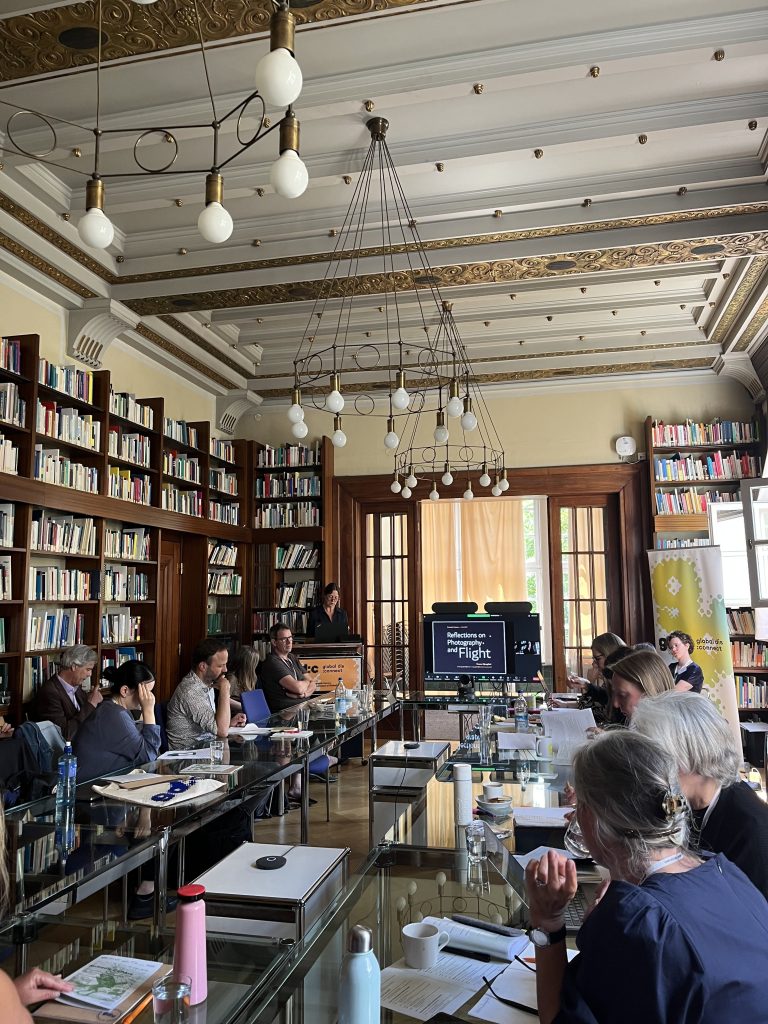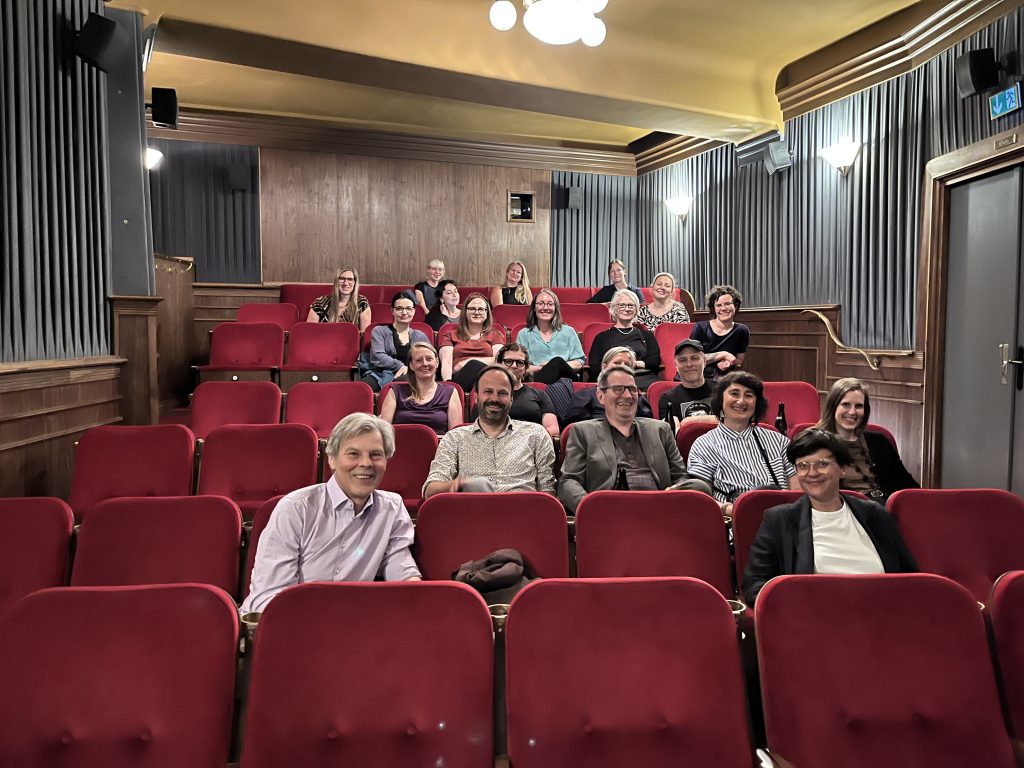Nomadic Camera: revisiting a workshop on photography and displacement at gd:c
sophie eisenried


Figure 1: Erich Stenger, Die Geschichte der Kleinbildkamera bis zur Leica, (Wetzlar: Umschau Verlag, 1949), 16.[1]
From 13 June to 15 June 2023, a hybrid international workshop bearing the title Nomadic Camera. Photography, Displacement and Dis:connectivities took place at the Käte Hamburger Research Centre global dis:connect in cooperation with the Brandenburg Centre for Media Studies (ZeM) Potsdam. Nomadic Camera was dedicated to processes of migration, exile and flight and their visualisation, perception and dissemination through photography. The workshop explored the technical, medial and aesthetic relationship between photography and contemporary migration, historical exile and flight as a central discursive setting in which specific forms of mobility are negotiated from the mid-19th century to the present. The interdisciplinary workshop was organised by Burcu Dogramaci (Munich), Jens Jäger (Cologne), Winfried Gerling (Potsdam) and Birgit Mersmann (Bonn). The workshop kicked off with the gd:c annual lecture given by T. J. Demos (Santa Cruz) on the topic of Weaponized Environments. From the Migrant Image to the Media of Causes.
Annual lecture, 13 June 2023
In his lecture, T. J. Demos talked about the dynamics and aesthetics of migratory images and probed the representational regimes of refugees. He described the mobility of images of migration and problematised the migrant as a representational subject. He noted that images of migration became mobile screens onto which all kinds of content can be projected by liberal and right-wing media alike. Demos concluded that such projection is driving the rise of epistemic inaccuracies in images and their lack of documentary potential, which themselves are due to visually simplifying image regimes and resulting political interests. He described this development as a photography of faces, whereby subjects are reduced to their physiognomy. As a result, migrants have been dramaturgically and racially limited to their stories (of flight), and no critical reporting takes place.
Demos then proposed a shift from a photography of faces to a photography of causes, asking what aesthetics and image regimes were necessary to legitimise this shift. For him, the answer lies in linking the concept of figure with that of ground, not considering environments as neutral contexts but rather asking how images and subjects are connected. He proposed forensic research as well as politically comprehensive analyses to paint a clear picture of political and economic antagonisms and to show networks of power by challenging racialised images in media.

Figure 2: Annette Vowinckel introducing Noemi Quagliati (photo by the author).
14 June 2023
Nomadic Camera began with processes of migration and flight after 2015 and their representation, perception and dissemination through photography. The participants examined the relationship between photography and contemporary migration in technology, media and aesthetics as well as historical exile and flight as central discursive settings. Reflections on creating places and belonging, ruptures between life and work in the past and present, experiences of loss and challenges of beginning were prominent topics. As a concept, nomadic camera focuses on:
- how dislocations relate to the technical development of photography as a mobile medium;
- how camera technologies presuppose and influence the visual formulation of experiences of exile, migration and flight;
- what changes in the aesthetics and style, methods and practices of photography imply for temporary mobility, geographical displacement and resettlement.
The first panel was dedicated to the topic of techniques and technologies. Beyond discussing the camera as an artificial object, the participants also considered how perspectives of shooting and their results have changed concepts of photography.
Svea Bräunert (Potsdam) connected techniques and technologies of nomadic cameras to the fact that the 21st century is hardly imaginable without accounting for the digital. For her, ‘the digital’ refers to migrants’ (as she referred to them) use of smartphones to plan their escape routes and stay in touch with their social networks as well as to the virtual fortification of borders through surveillance, biometrics and other technologies. She described migrant aesthetics as a ‘moving stream’, in which movement is central in determining the connection between the digital and migration. She concluded that films can no longer be clearly distinguished from photographs. While films have slowed, now containing abstract-looking still images, photography has become a stream always consisting of multiple images. As well as exemplifying what Nathan Jurgenson described as ‘social photos’,[2] the latter also defines smartphone photography, where one image is synthesised from many shots and motion is routinely added.
Florian Krautkrämer (Lucerne) took a different tack, asking what dangers and responsibilities participatory techniques of filmmaking entail in the context of flight and migration. He pointed out that the participatory often makes use of the pain, fear and worries of others. The question of who films what for whom arose. Referring to, Wu Wenuang’s China Village Self-Governance Film Project, which captures the public and political life of Chinese villages through the lens of their inhabitants, Krautkrämer emphasised that it is important to distinguish between the handed-over and the given camera. The handed-over camera reduces people with specific goals to human tripods. With the given camera, on the other hand, not everything is predetermined; the nature of the camera is important to the outcome. Although no political conflicts can be solved by the given camera, the filmed person can receive a hearing and attention. Thus, Florian Krautkrämer claims that the given camera is more politically open.
The second panel was dedicated to bodies, agents and performativity. The discussion focused on the importance of the context of images/photographs and drew attention to the performative character of photography and a theorisation of the term agency. Burcu Dogramaci asked how the concept of the performative relates to migrant photography.
Lara Bourdin (Montreal) addressed that question by talking about Notícias de América, a performance by Paulo Nazareth. The Afro-indigenous Brazilian artist pictured himself alone and together with anonymous people holding a cardboard sign. One of the signs, for example, bore the inscription: ‘I am not migrating to the USA’. The surrounding elements, however, suggested otherwise. With his simple clothes and dirty feet, Nazareth recalled the stereotypical figure of the *Latin American migrant* that circulates in Western documentary photography.[3] By developing an imaginary migration story, a re-enactment of real migration stories of people and bodies took place, whereby the performance is a direct, political intervention that exposes forms and racialising processes of photojournalism.
Evelyn Runge (Cologne) took a step back from the performative and asked about agency. She examined the ethics and agency of digital images and photojournalistic experiences with the help of the actor-network-theory.[4] She found that ethics and agency are strongly intertwined and asked whether the nomadic digital represents the new ‘normal’. She attested to the participatory nature of the digital image through mechanisms such as reposting on social media and describes this process as nomadic. Afterwards, T. J. Demos asked whether the term nomadic is not inflationary and whether the nomadic is falsely equated with precarity and migration more generally.

Figure 3: The workshop participants enjoyed an evening viewing at the Arena Cinema in Munich (photo by the author)
15 June 2023
At the beginning of the third panel, devoted to media narrations and narratives, Birgit Mersmann pointed out that photo stories contribute to the narrative of migration and that, with the advent of new media and the resulting storytelling possibilities, narratives of migration have undergone a techno-social change. She probed the connections between media historiography, the nomadic camera and new narratives photography is producing. She noted that means of displacing and interrupting narratives can be analysed and distinguished in photographs.
Anna Messner (Düsseldorf) added that there is a contradiction between what is seen/displayed and the actual event, referring to how objects can oscillate between visibility and invisibility — appearing, disappearing then reappearing — depending on the context in which media like photo albums are viewed.
Subsequently, Ainslie Murray (Sydney) discussed narrative interruptions in her own art project called Registry of Itinerant Architectures — a dynamic online registry of wild, mobile, temporary and inventive forms of architecture associated with contemporary nomadic life. She talked about how her project began, about her walk through the wilderness in central Australia on the Larapinta trail from May to October 2022 during the Covid-19 pandemic. She referred to her preparations, initially hiking in a group and then deciding to continue her journey alone. The fears and worries that repeatedly interrupted her journey were captured through artistic/photographic methods in her art project. But besides creating images of interruptions, the images show improvised scenes of place-making and offer insights into the intense physical and psychological dimensions of mobility, characterised by risk, repetition, interruptions and failure where the landscape played an important role, as in the search for shade.
The fourth panel dealt with circulation, archive and memory. Jens Jäger asked what and how we think about the term circulation and what forms of knowledge production play a role. He suggested the archive as a place where knowledge is stored and ascribes it to a tradition of reliving biography. Memory is the constant movement of experience. The archive also shapes ideas about and memories of migration and is therefore significant to nomadic cameras.
Helene Roth (Munich) reflected on the archive by discussing her analyses in the ERC project Relocating Modernism: Global Metropolises, Modern Art and Exile (METROMOD). In recent years, the team has developed an interactive digital archive of emigrant artists in the six METROMOD cities of Bombay, Buenos Aires, Istanbul, London, New York and Shanghai. The archive not only contains archive entries, but also locates home and work addresses on city maps. The archive also provides important research-based insights. Roth investigated photographers who emigrated to New York in the 1930s and 40s, asking who inscribed themselves in the city’s history and how. How are the emigrant photographers (in)visible on the city map? In what contact zones, networks and specific neighbourhoods did they work and live in New York? How were transcultural networks between the METROMOD cities created by migration movements? Roth described the challenges of handling of fragmentary information, which in turn is connected to media like photography. However, the digital archive lends itself to visualising fragmentary and nomadic knowledge through, for example, maps.
Afterwards, Zeynep Gürsel (New Brunswick) mentioned that every archive contains certain temporalities. She looked at the effects of the ghostly presence of photographs in an archive of the Ottoman Empire, from which those photographed and captured had left the country without a chance to return. Zeynep Gürsel traces the circulation of 393 individuals and photographs to examine mobility, nationality, archives and the construction of individual and collective memories. She found that each image contains two temporalities: that of the Armenian past and the future of the homeland to-be.
Elizabeth Edwards (Leicester) contextualised thoughts on memories with a historiographical intervention on the archive. She used Zygmunt Bauman’s term liquid times, which refers to the uncertainties in contemporary society, in which mass migration and the fluid definition of ‘home’ are essential features.[5] She asked how photographs produce strong histories, as she named them, and suggested that this is only possible because of their fluidity, in that their power structures and political and social agency change depending on what one inscribes on the image. However, images are used/understood as witnesses as well as legitimators of existences around which we, as humans, construct our realities, make new connections and thus create a tapestry of history and reality.
The final discussion, beyond those sadly not mentioned here, was devoted to defining the term nomadic camera and, more broadly, what the nomadic might be. It quickly became clear that there is no one exclusive definition of nomadism, let alone the nomadic camera. It is much more important, as numerous discussions and lectures have confirmed, to refer to the political in the nomadic, recalling Demos’s lecture about the danger of romanticising the nomadic as boundless travel and thereby overlooking the fact that the less privileged are excluded from this freedom.[6] Hence, it is necessary to recognise and analyse technologies, agents, narratives and archives of nomadic cameras, without forgetting that nomadic does not inevitably mean freedom and that freedom remains a fantasy for many.
[1] Erich Stenger, Die Geschichte der Kleinbildkamera bis zur Leica (Frankfurt am Main: Wetzlar, Leitz, 1949).
[2] Nathan Jurgenson, The Social Photo: On Photography and Social (London/New York: Verso, 2019).
[3] I refrain from further explaining or exemplifying the stereotype of the *Latin American Migrant* in order to avoid reproducing racist representations.
[4] Bruno Latour, Reassembling the Social: An Introduction to Actor-Network-Theory (Oxford: Oxford University Press, 2007).
[5] Zygmunt Bauman, Liquid Modernity (Cambridge: Polity Press, 2000).
[6] T.J. Demos, The Migrant Image The Art and Politics of Documentary during Global Crisis (Durham: Duke University Press, 2013).
bibliography
Bauman, Zygmunt. Liquid Modernity. Cambridge: Polity Press, 2000.
Demos, T.J. The Migrant Image The Art and Politics of Documentary during Global Crisis. Durham: Duke University Press, 2013.
Jurgenson, Nathan. The Social Photo: On Photography and Social. London/ New York: Verso, 2019.
Latour, Bruno. Reassembling the Social An Introduction to Actor-Network-Theory. Oxford: Oxford University Press, 2007.
Stenger, Erich. Die Geschichte der Kleinbildkamera bis zur Leica. Frankfurt am Main: Wetzlar, Leitz, 1949.





